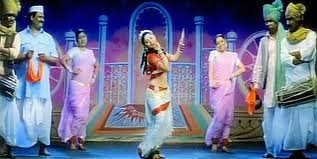
A tamasha is a traditional theatre art form of Maharashtra, prevailing since the 18th century in most parts of rural Maharashtra. Tamasha was exclusively performed by boys and young men due to varied reasons. During the reign of kings, varied stories were narrated and enacted through the medium of music, dance, acting and dialogue delivery. Playing a key role in a tamasha is the vidushak or songadya (comedian). The comedian is also the coordinator, who narrates the entire story with jokes in between that indirectly portray the ills of society in a humorous manner.
The popular folk dance of Maharashtra known as lavani forms an integral part of a tamasha. While lavani is extremely popular in urban areas, the tamasha is still more prevalent in rural areas, wherein thousands are attracted to watch and be entertained with a night long performance. There are around 15,000 families who are practitioners of this art form, and include dancers, musicians, make-up artists and other technical staff involved in the organisation of a performance.
Significance of the tamasha and its evolution
Tamasha literally means ‘dispeller of darkness’ in Marathi. It can be traced to the 18th century when Peshwa spies picked up the art from Mughal military camps and made it their own. The traditional lavani, a forerunner of tamasha, was an amalgamation of kavya (poetry), sangeet (music) and abhinay (acting).
The current format includes a wholesome entertainment showcasing gan (musical and lyrical prayers to Lord Ganesh), gavlan (musical and lyrical tribute to Lord Krishna, Radha and his various milk gathering women, his love interests), rangabaji (songs and dances including lavani), batanavni (skits and banter between anchors) and vagnatya (a full-fledged play).
There are two types of tamashas, namely fadacha and sangeet bari. While fadacha gives more importance to light-hearted humour and acting, sangeet bari lays emphasis on music with a lot of dances as well.
Music
A four-piece orchestra consisting of an organ, dholki (percussion instrument), clarinet and halgi (small drum), support the singing, that does not emphasize melody but dramatization and follows the natya sangeet (drama music) that forms the hallmark of Marathi theatrical productions. A doyen among folk artists, Pathe Prabhu Rao Kulkarni has rearranged the music and lyrics with the objective of education through entertainment. Nevertheless popular Marathi and Hindi film songs have been adapted for mass appeal.
Costumes, make-up and performances
With the inclusion of women performers, tamasha has become quite popular, particularly, the lavani. The make-up used is quite ordinary but sometimes garish, too. Women are attired in the traditional nine-yard saree which is stitched in such a way, like a dhoti, to make it comfortable to dance and sometimes jump too, according to the story or scene depicted. The male dancers or actors, the drummer, the singer and the comedian used to move and dance along with the dancers but recently changes have been introduced pertaining to the style of presentation.
Social relevance of a tamasha
The tamasha is socially relevant because it is a well balanced performance – the songs and dances are there to entertain while the skits and plays are socially relevant. Tamashas cover a wide range of social issues and the speciality is that they do it in a dramatic manner, using humour, thus connecting with people instantly.
Tamasha performances are a combination of information, education and entertainment. Many a time they are a medium used as social correctives too. Many plays are based on Sangeet Bari, an award-winning book written by Bhushan Koregoankar.
Ganpat Rao Mane, owner of Loknatya Tamasha Mandal, Chinchini in Sangli district of Maharashtra, has penned socially-relevant tamasha plays like Maharashtra Chuktay Nahi (Maharashtra Won’t Be Divided), a historical on the life of Sambhaji, Lagan Adhi Kum Kum Posle (Widowed Before Marriage), Dnyaeshwar Maji Mouli (Dnyaeshwar My Mother), Janma La Indira Punha (Indira Be Born Again), Ase Pudhari Thar Kara (Kill Such Corrupt Leaders), Hunda Rakt Mangat Ahe (Dowry Demands Blood), etc.
Eminent performers
Vithabai Narayangoankar is a veteran performer while both Satyabhamabai Pandarpurkar and Shabubai are Sangeeta Natak Akademi winners. Anil Vasudevan, despite being a Malayalee, is the choreographer and director of Bin Baicha Tamasha (Tamasha Without Women) group consisting of all male dancers who excel in the female disguise, and has already rendered thousands of performances winning wide acclaim and appreciation. Anil Vasudevan is a Bharata Natyam and folk dance exponent and dance teacher for over four decades.
Tamasha is widely performed by local or travelling theatre groups within the state of Maharashtra with great appeal to the local folks. Its themes have also become the subject of several Marathi films. Today, it has become an awareness weapon, which can challenge norms and often embraces rebellious issues for the common man.
Picture Credit : Google




